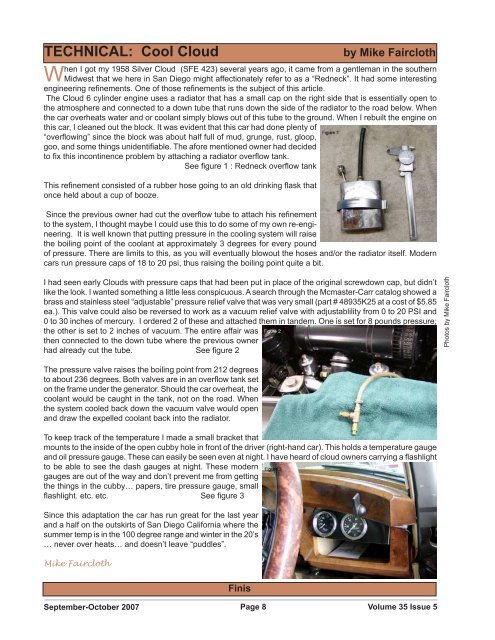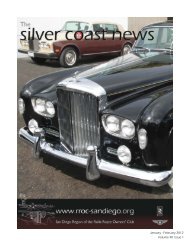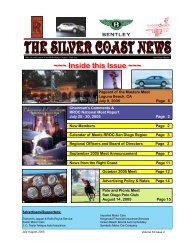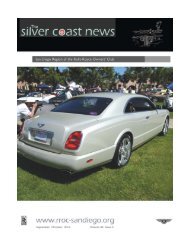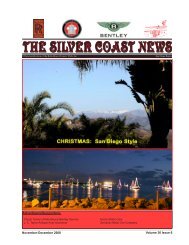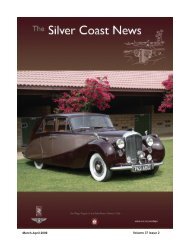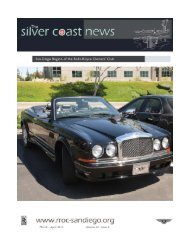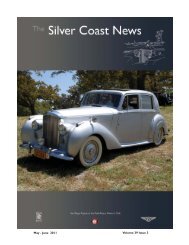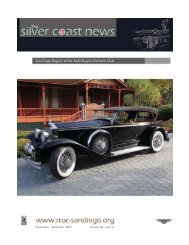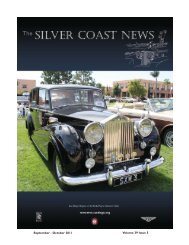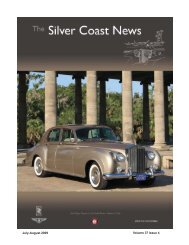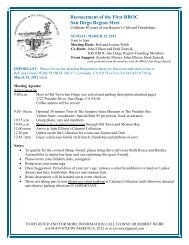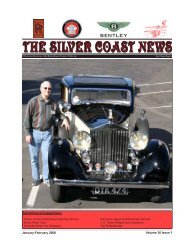September-October - RROC - Rolls Royce and Bentley Owners of ...
September-October - RROC - Rolls Royce and Bentley Owners of ...
September-October - RROC - Rolls Royce and Bentley Owners of ...
Create successful ePaper yourself
Turn your PDF publications into a flip-book with our unique Google optimized e-Paper software.
TECHNICAL: Cool Cloud by Mike Faircloth<br />
When I got my 1958 Silver Cloud (SFE 423) several years ago, it came from a gentleman in the southern<br />
Midwest that we here in San Diego might affectionately refer to as a “Redneck”. It had some interesting<br />
engineering refinements. One <strong>of</strong> those refinements is the subject <strong>of</strong> this article.<br />
The Cloud 6 cylinder engine uses a radiator that has a small cap on the right side that is essentially open to<br />
the atmosphere <strong>and</strong> connected to a down tube that runs down the side <strong>of</strong> the radiator to the road below. When<br />
the car overheats water <strong>and</strong> or coolant simply blows out <strong>of</strong> this tube to the ground. When I rebuilt the engine on<br />
this car, I cleaned out the block. It was evident that this car had done plenty <strong>of</strong><br />
“overflowing” since the block was about half full <strong>of</strong> mud, grunge, rust, gloop,<br />
goo, <strong>and</strong> some things unidentifiable. The afore mentioned owner had decided<br />
to fix this incontinence problem by attaching a radiator overflow tank.<br />
See figure 1 : Redneck overflow tank<br />
This refinement consisted <strong>of</strong> a rubber hose going to an old drinking flask that<br />
once held about a cup <strong>of</strong> booze.<br />
Since the previous owner had cut the overflow tube to attach his refinement<br />
to the system, I thought maybe I could use this to do some <strong>of</strong> my own re-engineering.<br />
It is well known that putting pressure in the cooling system will raise<br />
the boiling point <strong>of</strong> the coolant at approximately 3 degrees for every pound<br />
<strong>of</strong> pressure. There are limits to this, as you will eventually blowout the hoses <strong>and</strong>/or the radiator itself. Modern<br />
cars run pressure caps <strong>of</strong> 18 to 20 psi, thus raising the boiling point quite a bit.<br />
I had seen early Clouds with pressure caps that had been put in place <strong>of</strong> the original screwdown cap, but didn’t<br />
like the look. I wanted something a little less conspicuous. A search through the Mcmaster-Carr catalog showed a<br />
brass <strong>and</strong> stainless steel “adjustable” pressure relief valve that was very small (part # 48935K25 at a cost <strong>of</strong> $5.85<br />
ea.). This valve could also be reversed to work as a vacuum relief valve with adjustablility from 0 to 20 PSI <strong>and</strong><br />
0 to 30 inches <strong>of</strong> mercury. I ordered 2 <strong>of</strong> these <strong>and</strong> attached them in t<strong>and</strong>em. One is set for 8 pounds pressure;<br />
the other is set to 2 inches <strong>of</strong> vacuum. The entire affair was<br />
then connected to the down tube where the previous owner<br />
had already cut the tube. See figure 2<br />
The pressure valve raises the boiling point from 212 degrees<br />
to about 236 degrees. Both valves are in an overflow tank set<br />
on the frame under the generator. Should the car overheat, the<br />
coolant would be caught in the tank, not on the road. When<br />
the system cooled back down the vacuum valve would open<br />
<strong>and</strong> draw the expelled coolant back into the radiator.<br />
To keep track <strong>of</strong> the temperature I made a small bracket that<br />
mounts to the inside <strong>of</strong> the open cubby hole in front <strong>of</strong> the driver (right-h<strong>and</strong> car). This holds a temperature gauge<br />
<strong>and</strong> oil pressure gauge. These can easily be seen even at night. I have heard <strong>of</strong> cloud owners carrying a flashlight<br />
to be able to see the dash gauges at night. These modern<br />
gauges are out <strong>of</strong> the way <strong>and</strong> don’t prevent me from getting<br />
the things in the cubby… papers, tire pressure gauge, small<br />
flashlight. etc. etc. See figure 3<br />
Since this adaptation the car has run great for the last year<br />
<strong>and</strong> a half on the outskirts <strong>of</strong> San Diego California where the<br />
summer temp is in the 100 degree range <strong>and</strong> winter in the 20’s<br />
… never over heats… <strong>and</strong> doesn’t leave “puddles”.<br />
Mike Faircloth<br />
<strong>September</strong>-<strong>October</strong> 2007<br />
Finis<br />
Page 8 Volume 35 Issue 5<br />
Photos by Mike Faircloth


